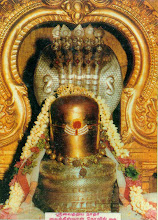Samayakuravar (The four Great Saint of Saiva Religion - before in 10th century)
Saiva siddhantham speaks of four steps in spiritual progress. They are Sarya(work to others) Kriya,Yoga,and Gnana. These four saiva Acharyas, Thirunavukkarasar (Appar), Thirugnanasambandhar, Sundharar, Manickavasagar, are supposed to represent these four methods.The Thevaram and Thiruvasagam which comprise the first eight books of the Thirumurai constitue the bedrock of saivism. The lives of the four great Acharys form part of their songs and consititute a unified lesson and inspiration for the saivites and their philosphy.
1. Thirunavukkarasar (Appar)
His songs are mellow, didactic and delicately emotional. He is humble and his attitude to god is that of a servant to his master. He also gives a new orientation to hinduism by laying emphasis on service to god and fellowmen. My duty is to serve is his motto. Thirunavukkarasar and his divotees renovates the many sivan temples, that team is called "uzhavara padai". Thirunavukkarasar (Appar) was the great example for Sarya bakthi.
2. Thirugnanasambandhar
He is a boysaint, He takes some liberties with his father(siva). He takes delight in music. He sees god in nature and fine arts. Thirugnanasambandhar was the great example for Kriya bakthi.
3. Sundhararmoorthy Nayanar
He was very much of this world,having two wives and having luxurious life.But he never forgotten the lord,whom he considered as his friend and on whom he depend for every kind of help. Sundhararmoorthy Nayanar was the great example for yoga bakthi.
4. Manickavasagar
He was unique in many respects. His highly emotional love for god and the urgency shown by him for union with him is comparable to the love between the lovers. Manickavasagar was the great example for Gnana bakthi.
santhAnak kuravar
santhAnak kuravar are the gurus who gave to this world the philosophy of shaiva sidhdhantha. They are in two classifications.
agach chandhAnak kuravar
They are four in number. They are not the normal human beings but the ones who live in the Holy Mount kailash (deva paramparai). The Prime Guru of this tradition is the Supreme guru dakshiNAmUrthi. These four gurus are:
1. thirunandhi dhevar
2. sanath kumarar
3. sathya nyana dharshinigaL
4. paranychOdhi munivar
Adhi guru shri dakshinamurthi is the guru for thirunandhi dhevar. thirunandhi dhevar is the guru of sanath kumarar and so on.
puRach candAnak kuravargaL
They are also four in number. This tradition starts with the last in the agachchandhAnak kuravar - paranychOdhi munivar as the root. The four generations of disciples in this tradition are:
1. Meikandar or meikanda shivam or meikanda devar
2. Arulnandhi shivam
3. Marainyana sambandhar
4. Umapathi shivachariyar
paranychOdhi munivar was the guru of meykaNDAr. The four mentioned above lived in this earth (bUdha paramparai) in thamiz land and gave answers to much difficult philosophical questions in the form of shaiva sidhdhanthic explanations. Further disciples of this tradition established the mutts at thiruvAvaDuthuRai and dharumapuram (namachchivaya murthikaL and gurunyAna sambandhar respectively). Since this tradition starts from Lord dakshiNAmUrthi at Holy mount kailash, the two mutts get the title kayilAya paramparai. The philosophic texts composed by the san^thAna kuravar are called santhAna noolgaL(1). (A few of them are composed by others who are not part of this four). These fourteen are regarded as the saththiram (basis, scriptures) texts.
About Me

- Adiyaarku-adiyen
- Five faces of shivam are Easanam,Thathpurusam, Agoram, Vamadheyam, Sathyojatham. Meikanda Shasthram says three types of worship. *Arupa {Niskala} - formless[empty]. *Rupa {Sakala} - means forms of worship,fully manifested[Natarajar]. *Rupa Arupa {Niskalasakala} -formless form[Sivalingam]. Sarvam Shiva Mayam
Subscribe to:
Post Comments (Atom)





சங்க இலக்கியங்கள் பலவற்றில் ‘குறவர்கள்’ என்ற மலையக இனம் குறிப்பிடப் பட்டுள்ளது. முருகப் பெருமானுக்கு வள்ளியை மணம் செய்து கொடுத்த இனம் குறவரினம் என்பது பலரும் அறிந்த ஒன்று. (சமயக்) குரவர்கள், குறவர்கள் இரண்டும் ஒன்றா? வெவ்வேறு என்றால், குரவர்கள் என்பதன் அடிப்படைப் பொருள் என்ன? சமயக் குரவர்கள் என்ற இடம் தவிர வேறெங்கேனும் குரவர்கள் என்ற சொல் பயன்படுத்தப் பட்டுள்ளதா?
ReplyDelete